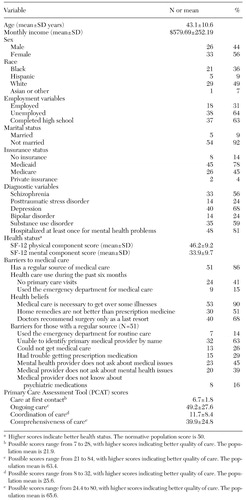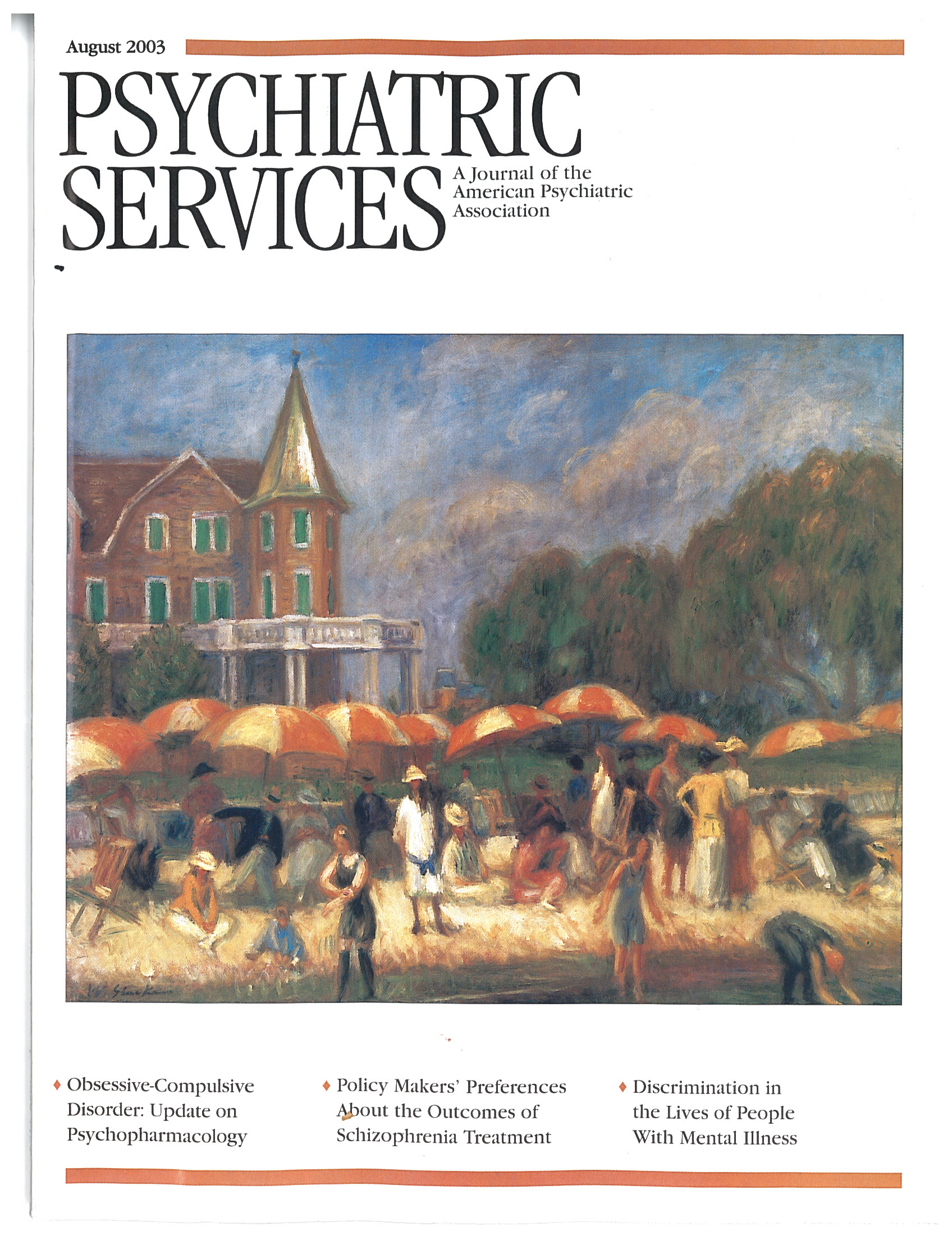Barriers to Primary Medical Care Among Patients at a Community Mental Health Center
Abstract
People with chronic mental disorders may be at risk of reduced access to medical treatment and poor quality of medical care. The authors examined receipt of and barriers to medical treatment among patients at a community mental health center. Fifty-nine patients completed a validated instrument for measuring access to medical care and the quality of primary care. Their responses indicated problems with access to care, and their scores were significantly lower than those of the general population on all four domains used to assess the quality of primary medical care. The findings suggest the need for community mental health centers to better assess and address barriers to primary medical care.
Medical mortality and morbidity is elevated among patients with serious mental disorders. Lack of adequate medical care may be one factor in these poor outcomes (1). As a result of a variety of factors at the patient, provider, and system level, people with chronic mental illnesses may face barriers to obtaining adequate medical care and are at risk of "falling through the cracks."
Although community mental health centers assume a central role in providing mental health care to people with chronic mental disorders, little is known about the medical care received by patients of these facilities. In this study we examined access and barriers to medical care in this population by using a structured survey based on patients' self-reports.
Methods
Names of potential participants were randomly chosen from a roster of all patients seen at one community mental health center in the year before the study. Fifty-nine of 63 potential respondents (94 percent) participated in the survey, which consisted of a two-hour interview conducted in a private room by a trained research assistant. The study, conducted between October 2000 and September 2001, was approved by the university's human investigations committee.
Information about patient characteristics, such as age, income, race, employment, education, insurance, and medical conditions, was self-reported by the patients. Psychiatric diagnosis was extracted from patient records.
To assess six-month use of primary medical services, emergency department care, outpatient specialty and mental health care, inpatient hospital stays, and medications, interviewers asked patients questions drawn from the section on health care access and utilization of the National Health Interview Survey (2).
Questions about health beliefs were selected from the Health Belief Index (3), which is based on Becker's model and attempts to explain health behaviors on the basis of patients' attitudes about medical care and illness (4). The physical component summary (PCS) and the mental component summary (MCS) of the 12-item Short-Form Health Survey (SF-12) were used to measure physical and mental health status (5).
The Primary Care Assessment Tool (PCAT) was used to assess the quality of the four cardinal features of primary care: care provided at first contact, ongoing care, comprehensiveness of care, and coordination of care (6). Care at first contact is the degree to which the primary care provider serves as an entry point to the health care system each time a new problem develops. Ongoing care refers to long-term relationships between the physician and the patient. Coordination of care is characterized by the availability of information about previous problems and services so that efforts toward patient care are targeting the same goals. Comprehensiveness of care specifies that the primary care provider identifies a patient's full range of health-related needs and puts together the resources to meet those needs. Higher PCAT scores indicate better quality of primary care.
Mean scores on the SF-12 and the PCAT were compared with general population means (5,6) by using z scores. Bivariate comparisons were then used to assess the relationship between clinical factors and measures of access to primary care. All analyses were performed by using SAS, version 8.0.
Results
Demographic, diagnostic, and health-related characteristics of the study sample are summarized in Table 1. Mean MCS and PCS scores were substantially below—that is, worse than—the normative population scores of 50 (33.9±9.7, z=12.64, p<.001 for the MCS and 46.2±9.2, z=2.64, p<.004 for the PCS) (5). The most common medical problems were cardiovascular disease, diabetes, hypertension, arthritis, and digestive disorders.
Eight study participants (14 percent) reported that they had no usual source of medical care. Among the 51 respondents who said that they did have a usual source of care, seven (14 percent) reported that they used the medical emergency department for their routine medical care needs. Nearly two-thirds (32 patients, or 63 percent) were unable to identify their primary care providers by name (Table 1).
Approximately 40 percent of the respondents indicated that coordination between their medical and mental health caregivers was poor—45 percent said that their mental health provider did not ask them about medical issues, and 39 percent said that their medical provider did not ask about mental health issues. Responses to questions about individual health beliefs indicated that this group of patients believed medical treatment was useful and did not question physicians' judgment (Table 1). Scores on the PCAT showed that this group of patients received substandard care in the four cardinal features of primary care described above.
The study sample had substantially lower scores than those of the general population in all four domains of quality of primary care (7). The biggest difference between the sample's scores and normative population scores was observed in the domain of first contact (6.7 compared with 21.9, z=-12.53, p<.001). The highest scores were observed in the domain of ongoing care; however, this score was still significantly lower than the normative population score (49.2 compared with 63.4, z=-3.81, p<.001).
Discussion
A majority of patients in this study reported having a regular source of medical care, yet these patients demonstrated that they had substantial unmet needs for medical care and that the quality of the primary medical care they received was poor. For these patients with major mental disorders, having a primary care provider did not guarantee access to high-quality medical care. Efforts to improve health care for this population may need to go beyond simply providing patients with general medical practitioners (8).
The lack of communication we observed between mental health and medical care providers suggests poor integration between the two types of care. The literature has identified common goals among providers as being beneficial for enhancing the coordination of general and mental health care (9). Deficiencies in ongoing care in this patient sample indicated that the patients had not established reliable sources of care over time. Patients were unsure of the availability of care to meet the full range of primary health care needs.
No evidence was found to indicate that failure to receive medical care was based on patients' reluctance to engage with the medical system or doubts about the benefits of medical care. Rather, even when patients were willing to obtain care, they were unable to get the care they needed.
Because a majority of the patients in this study were poor and had serious mental illness, they were covered by public medical insurance. Patients with less serious mental illness, although they face fewer barriers related to mental health symptoms, may face more obstacles related to lack of insurance (8).
Two sets of factors may have contributed to larger deficits in care for this sample of patients than those reported in previous studies of patients with serious mental disorders (1,10). First, earlier studies were conducted primarily at Department of Veterans Affairs facilities, where services for chronic mental illness may be more integrated than those in the community. Second, the method of data collection may be a factor. The PCAT uses patients' self-reports to capture the overall relationship between patients and their providers or institutions rather than administrative data or chart reviews, which are more useful for assessing the use of discrete procedures. Future research should focus on determining the correlation between these two types of measurement and how they might best complement each other for assessing the quality of primary care for patients with serious mental illness.
This study had several limitations. First, the normative PCAT scores used in this study were based on patients from a health maintenance organization and a group of patients with low incomes in South Carolina (6). It is therefore possible that the lower PCAT scores in our study sample were due to other differences between the samples, such as financial or demographic characteristics. Second, because PCAT scores are based on patients' self-reports, they are potentially subject to recall or misclassification bias.
Third, the results of this study represent patients at only one site. However, the demographic traits of this group of community mental health center patients are similar to those of patients receiving care at other outpatient mental health facilities (10). Finally, the study findings were limited by the small sample. Future studies would benefit by the use of larger samples to make it possible to identify populations at particularly high risk of poor access and to better understand specific determinants of quality of primary care.
Conclusions
Although a majority of the patients who participated in this survey reported having a source of medical care and having contact with medical providers, the quality of the medical care they received was substandard. A recent study demonstrated that integration of care improved outcomes for patients with severe mental illness (9). Community mental health centers may wish to examine the value of better integrating medical and behavioral health care for the patients they serve.
Ms. Levinson Miller, Ms. Dombrowski, and Dr. Rosenheck are affiliated with the department of psychiatry of Yale University School of Medicine, 950 Campbell Avenue/151D, West Haven, Connecticut 06516 (e-mail, [email protected]). Dr. Druss is with the Rollins School of Public Health at Emory University in Atlanta. Dr. Rosenheck is also with the Department of Veterans Affairs Northeast Program Evaluation Center in West Haven.
 |
Table 1. Characteristics of a sample of 59 community mental health center patients who participated in a study of barriers to primary medical care
1. Druss BG, Bradford WD, Rosenheck RA, et al: Quality of medical care and excess mortality in older patients with mental disorders. Archives of General Psychiatry 58:565–572, 2001Crossref, Medline, Google Scholar
2. National Health Interview Survey (NHIS): Adult Core Survey Questionnaire. Hyattsville, Md, National Center for Health Statistics, 1997Google Scholar
3. Weissfield JL, Brock BM, Kirscht JP, et al: Reliability of health belief indexes: confirmatory factor analysis in sex, race, and age subgroups. Health Services Research 21:777–793, 1987Medline, Google Scholar
4. Becker MH: The health belief model and personal health behavior. Health Education Monographs 2:324–508, 1974Google Scholar
5. Ware JE, Kosinski M, Keller SE: How to Score the SF-12 Physical and Mental Health Summary Scales, 3rd ed. Lincoln, RI, Quality Metric Inc, 1998Google Scholar
6. Starfield B: Primary Care: Concept, Evaluation, and Policy. New York, Oxford University Press, 1992Google Scholar
7. Shi L, Starfield B, Xu J, et al: Validating the adult Primary Care Assessment Tool. Journal of Family Practice 50(2):E1, 2001Google Scholar
8. Druss BG, Rosenheck RA: Mental disorders and access to medical care in the United States. American Journal of Psychiatry 155:1775–1777, 1998Link, Google Scholar
9. Druss BG, Rohrbaugh RM, Levinson CM, et al: Integrated medical care for patients with serious psychiatric illness: a randomized trial. Archives of General Psychiatry 58:861–868, 2001Crossref, Medline, Google Scholar
10. Rosenheck RA, Desai R, Steinwachs D, et al: Benchmarking treatment of schizophrenia: a comparison of service delivery by the national government and by state and local providers. Journal of Nervous and Mental Disease 188:209–216, 2000Crossref, Medline, Google Scholar



